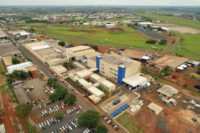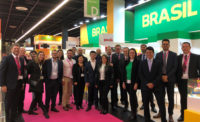It’s no secret that Brazil is on the world stage these days. After just hosting the World Cup last month, the country is now gearing up for its next big event — the 2016 Summer Olympics.
While much of the global news coverage has focused on Brazil’s capital improvement delays and costs, as well as its labor issues, there’s a lot more going on in this South American Country.
And APEX Brazil (the Brazilian Agency for the Promotion of Exports and Investments acts) is hoping to take advantage of having the country’s name in the ether.
Together with ABICAB (The Brazilian Cocoa, Chocolate, Peanut and Candies Manufacturers Association) they recently hosted Candy Industry Magazine for a week-long trip to Brazil to show off the country’s rich beauty and limitless potential.
The seven-day, whirlwind tour included three domestic flights and a different city every day.
While there, we toured the peanut candy company Santa Helena as well as the caramel maker Embaré. Then, on Friday, we went to the city of Ilhéus and toured the Leolinda cocoa farm, where they grow cocoa beans for the chocolate maker Nugali.
The trip also included a presentation from the company AMMA — a bean-to-bar Brazilian chocolate maker that’s working hard to educate Brazilians about exceptional chocolate — as well as a stop at the APAS Fair — where a variety of Brazilian confectioners were among the exhibitors.
It’s no surprise that Candy Industry was able to visit with so many confectioners while there.
Brazil is the fourth largest confectionery market in the world, behind only the United States, Germany and China. In fact, Brazilian confectionery products can be found in more than 10 countries on five continents. And, in 2012, the sector exported $335.8 billion in products.
As for the United States specifically, the Brazilian confectionery and peanuts industry represents about $12.7 billion of the market, according to Euromonitor.
But, of course, there’s always room for growth.
One of ABICAB’s main goals right now is to take advantage of the attention Brazil is getting —and using it for good.
Its strategy is two-fold.
On one end, Brazil’s own consumer base is growing like crazy, making it ideal for companies looking to import into the South American market.
But on the other end, ABICAB is working to convince Brazilian companies to export, and then helping them to do it successfully.
Rodrigo Solano, export manager for the organization, is in charge of preparing companies for the global marketplace.
He works with confectioners to create packaging that translates appropriately for various markets, and helps the Brazilian companies ready their products and message for different countries.
Solano also decides which companies are ready for various trade shows around the world, and then allows companies he deems ready to exhibit in the ABICAB booth at various events, such as the Sweets and Snacks Expo in Chicago.
Brazil’s export issues
And there are a lot of Brazilian companies vying for a piece of the international market.
Companies like Riclan, which is the biggest candy maker in Brazil, producing about 300 tons of candy each day. They already export to more than 60 countries, with exports making up about 18 percent of the business.
Riclan’s products include Freegells, Brazil’s second most popular menthol candy after Halls. The company also makes a lot of licensed bubble gum, including a One Direction gum, and jelly candy.
“We are always looking for new things,” says Henrique Lehmann, with Riclan’s export department.
He explains that one of the biggest issues his company faces is Brazil’s strong currency. The country’s rapid inflation over the last few years has strengthened Brazil’s money so much that it’s also made Brazilian exports more expensive in the world market.
Another factor leading to increased prices for Brazilian goods is somewhat bittersweet — better working conditions for the country’s workforce.
Luiz Eduardo, of Simas, says that as Brazil’s working and manufacturing conditions improve, its prices increase accordingly.
“So, the price has gone up for everyone,” he explains.
As companies work to overcome pricing issues though, they can at least know that Brazil has a mostly positive image throughout the world.
“Brazil, has a brand, and people like it,” Lehmann says. “People are curious about Brazil. They are looking to know about the country, and to know about the products.”
In fact, things are going so well for one Brazilian candy maker that it’s planning to open a manufacturing facility in the U.S.
Carlos Barion, chairman of Dori, which is the largest candy maker in Brazil, says his company plans to establish a plant in the United States to better facilitate distribution, likely in the Miami area, where APEX has an office.
And, the sweetest thing about Brazil may indeed be the fact that it’s the only county that can supply everything needed to make a candy bar — from the raw materials such as cocoa pods and sugar cane to the manufacturing facilities. It is truly a bean-to-bar country if there ever was one.
The country also boasts more than 300 fruit flavors and the fact that cocoa is originally from the Amazon Rain Forest, which covers about 57 percent of the Brazil.
Indeed, as ABICAB’s tag line says, it’s “Sweet Brasil – Made from the Heart.”












